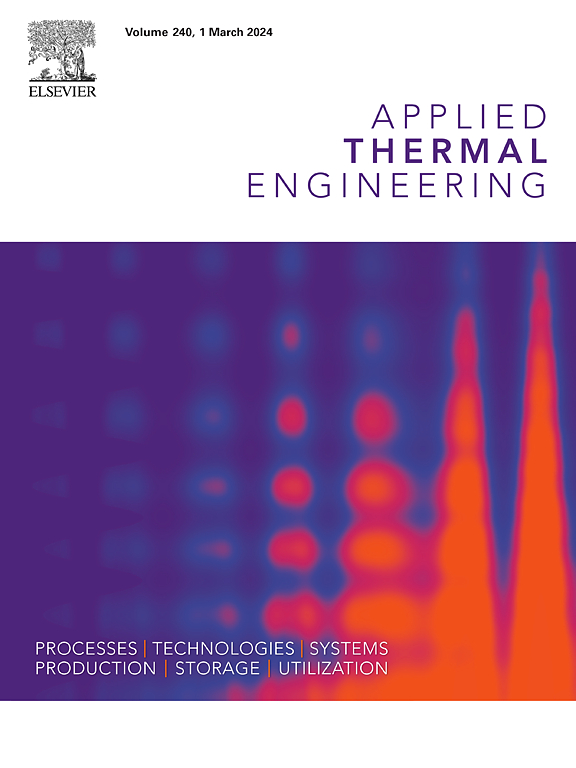Data-driven cooling tower optimization: A comprehensive analysis of energy savings using microsand filtration
IF 6.1
2区 工程技术
Q2 ENERGY & FUELS
引用次数: 0
Abstract
Effective management of cooling tower systems requires thorough water quality control. While traditional chemical water treatment methods are currently the most prominent strategy, they are costly and may yield limited results when relied upon as the sole approach. Cross-flow microsand filtration systems offer an interesting alternative with the added benefit of potentially increasing evaporative cooling efficiency, thus saving energy. The focus of the study was to evaluate the effect of these filtration systems on cooling tower operation. A comprehensive data-driven analysis over two cooling seasons evaluated the energetic performance of a system equipped with and without an operating filter using continuous monitoring and statistical modeling. For similar environmental conditions, the coefficient of performance was on average 18% higher and was higher 63% of the time when the filter was operating, indicating superior heat transfer efficiency and significant energy savings. It was also 41% higher during periods of high cooling demand. Consequently, the filter and the system work more efficiently at high wet-bulb temperature and thermal load. Machine learning modeling suggested that operating the filter year-round could save between 5% and 13% of the energy bill, primarily during the cooling season. Continuous filter operation is essential as it mitigates biofouling, underscoring its long-term significance, even during periods of lower thermal loads. The results of this study are significant for sustainability, public health and hold broader implications for cooling tower management. Integrating filtration systems into cooling tower management therefore fosters sustainable practices by decreasing energy consumption and biofouling. This study presents a novel approach by demonstrating, for the first time, the significant impact of continuous cross-flow microsand filtration on cooling tower efficiency, both in terms of energy savings and biofouling mitigation.
数据驱动的冷却塔优化:利用微砂过滤节能的综合分析
冷却塔系统的有效管理需要彻底的水质控制。虽然传统的化学水处理方法是目前最主要的策略,但其成本高昂,而且作为唯一的方法可能效果有限。错流微砂过滤系统提供了一种有趣的替代方法,其额外的好处是可能提高蒸发冷却效率,从而节约能源。这项研究的重点是评估这些过滤系统对冷却塔运行的影响。通过连续监测和统计建模,对两个冷却季节的数据进行了综合分析,评估了配备和未配备运行过滤器的系统的能效表现。在相似的环境条件下,过滤器运行时的性能系数平均高出 18%,有 63% 的时间性能系数都较高,这表明该系统具有卓越的传热效率和显著的节能效果。在制冷需求量大的时候,性能系数也要高出 41%。因此,在湿球温度和热负荷较高时,过滤器和系统的工作效率更高。机器学习建模表明,全年运行过滤器可节省 5% 至 13% 的能源费用,主要是在制冷季节。过滤器的连续运行至关重要,因为它可以减少生物污垢,即使在热负荷较低的时期,也能发挥长期作用。这项研究的结果对可持续发展和公众健康意义重大,并对冷却塔管理具有更广泛的影响。因此,将过滤系统纳入冷却塔管理可降低能耗和生物污垢,从而促进可持续发展。本研究提出了一种新颖的方法,首次证明了连续横流微砂过滤对冷却塔效率的显著影响,既节约了能源,又减少了生物污垢。
本文章由计算机程序翻译,如有差异,请以英文原文为准。
求助全文
约1分钟内获得全文
求助全文
来源期刊

Applied Thermal Engineering
工程技术-工程:机械
CiteScore
11.30
自引率
15.60%
发文量
1474
审稿时长
57 days
期刊介绍:
Applied Thermal Engineering disseminates novel research related to the design, development and demonstration of components, devices, equipment, technologies and systems involving thermal processes for the production, storage, utilization and conservation of energy, with a focus on engineering application.
The journal publishes high-quality and high-impact Original Research Articles, Review Articles, Short Communications and Letters to the Editor on cutting-edge innovations in research, and recent advances or issues of interest to the thermal engineering community.
 求助内容:
求助内容: 应助结果提醒方式:
应助结果提醒方式:


